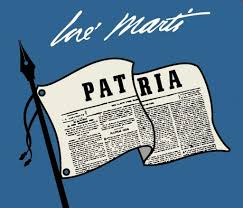Beyond his qualities as a patriot during his brief but fruitful existence, José Martí felt a great love for Cuba and dedicated himself entirely to the cause of the fight for its independence, and also to have been someone who contributed to the culture by creating many poems, several plays and a novel, his tenure as consul of Latin American countries in New York and also as a teacher, it can be said that he also stood out as a great journalist.
Very young he published his first work of a political nature in El Diablo Cojuelo, created by his great childhood friend Fermín Valdés Domínguez.
That was in January 1819, when he was about to turn 16. It is around two years later that Martí produces other works, and in this case in Spain, to where he was deported following his imprisonment with forced labor for his patriotic convictions.
In Spain, his first writing was a piece entitled “Castillo”, the family name of an old prisoner in Cuba, in which he detailed the situation suffered during days of forced labor in the San Lázaro Quarries. He then wrote another much broader work on the political prison in Cuba in which he quotes others who also suffered from it, including adolescents.
In 1873 Martí used journalism again, this time to demand that the Spanish rulers take into account the claim of the Cubans to achieve the independence of their homeland. In Spain, the Republic had been proclaimed and in a work entitled La República española ante la Revolución cubana , José Martí stated: Man of good will, I salute the Republic that triumphs, I salute it today as I will curse it tomorrow when a Republic drowns another republic , when a free people finally manages to compress the liberties of another people, when a nation that is explained as it is, subjugates and submits another nation that must prove that it also wants to be one.
In 1875 José Martí moved to Mexico to reunite with his parents and sisters who had settled in that country. And it is in Mexico when he has the opportunity to show his qualities as a journalist.
Through Manuel Mercado, with whom from then on he would maintain a significant friendship, he became related to the direction of the Universal Magazine. First he published some poems and materials and later became part of its team. He produced multiple articles and that actually marked the course of his life in the journalistic field.
After returning to Cuba where he stayed from mid1878 until September of the following year, Martí once again left for Spain, this time also deported, but then only stayed in the Iberian country for about three months, when he decided to move to the United States and settle in New York City .
He then wrote some works for different publications, and in January 1881 he traveled to Venezuela, where he had another great opportunity in the field of journalism when he associated to La Opinión Nacional newspaper from Caracas. In addition to this, it was in Venezuela, with the support of the directors of the aforementioned publication, that he was able to create and direct a magazine, which unfortunately could only be published twice, because of the angry reaction caused in the country’s ruler by one of the works in the second edition. The immediate suspension of the publication was decreed and Martí was forced to leave Venezuela.
He then returned to New York, but initially maintained relations with La Opinión Nacional, to which he sent a large number of works, and later managed to establish systematic links with La Nación in Buenos Aires, Argentina.
In the United States, the Apostle of our independence also elaborates materials for La América, a publication that he manages to direct, and in 1889 he undertakes the beautiful project of writing for the children of America through the magazine La Edad de Oro, of which 4 editions were published. The cessation of the publication of the magazine was not because Martí gave up on that effort, but because of contradictions that arose with its editor.
Already in 1892 when he was intensely involved in his objective of getting the war for independence resumed in Cuba, Martí created the newspaper Patria, whose first issue circulated in New York on March 14 of that year.
José Martí conceived Patria as a spokesman for Cuban emigration and as an effective way to intensify the revolutionary propaganda campaign in favor of the fight for the independence of Cuba and Puerto Rico. In its first issue appeared an article of his titled Nuestras ideas(Our ideas), in which he detailed the objectives of the publication, when he said: “To unite and love, and to live in the passion of the truth, this newspaper was born.”
In that work, he also highlighted the need to wage war for the independence of Cuba. He also made a reflection in the aforementioned article on the characteristics of human beings by stating that the strong anticipate and that second-hand men await the storm with arms outstretched.
For several years, until close to his death in 1895, Martí encouraged the publication of Patria and continued to write for the said newspaper, aware of the great role that fighting through the force of words could play.
Since 1992, on the occasion of commemorating the centenary of the publication of the first issue of the newspaper Patria, it was decided to celebrate annually on the date of March 14 the Day of the Press in Cuba.
Every year, a day is held in which, among other activities, the Annual Prize for Journalism “José Martí” is awarded for the work of life to outstanding journalists, as well as the Annual Juan Gualberto Gómez Prize to those who have excelled during the period covered for their work in the different media and in specialties such as photojournalism, graphics and hypermedia.
Author: Víctor Pérez-Galdós Ortíz
Gilda Gil



